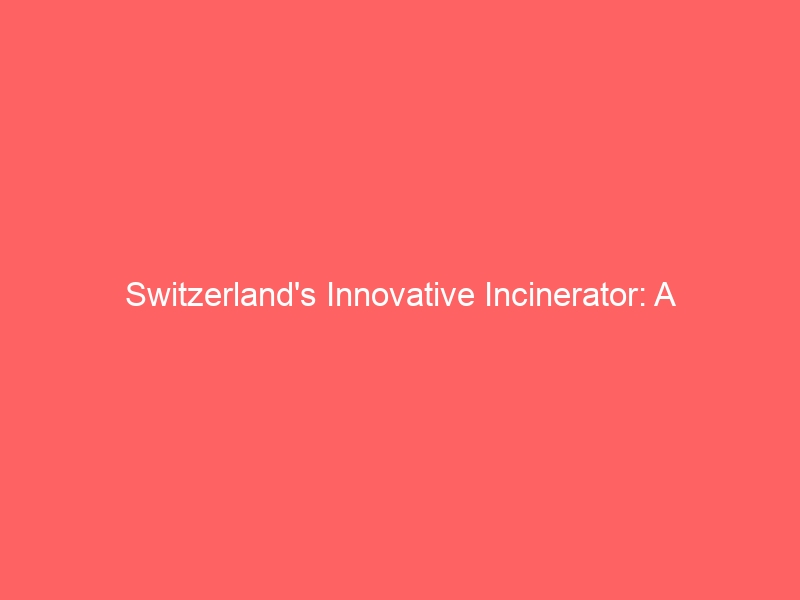Switzerland’s Innovative Incinerator: A Sustainable Solution for Waste Management
Switzerland is a country known for its efficient waste management system, and a key aspect of this system is its innovative incinerator facilities. These state-of-the-art facilities not only help to deal with the country’s waste problem, but also contribute to the generation of clean energy. In this article, we will take a closer look at Switzerland’s incinerator facilities and how they are helping the country to manage its waste in a sustainable and environmentally friendly manner.
What is an Incinerator?
An incinerator is a facility designed to burn waste at high temperatures, converting it into ash, gases, and heat. The heat generated from incineration can be used to produce electricity and heat buildings, making it a more sustainable and environmentally friendly alternative to landfilling.
Switzerland’s Approach to Waste Management
Switzerland is a country that is dedicated to sustainability and environmentally friendly practices. As a small, mountainous country with limited space for landfills, Switzerland has had to find innovative solutions to manage its waste. Their approach to waste management focuses on reducing waste generation, recycling and composting, and finally, incineration. The country has one of the highest recycling rates in the world, but the remaining waste that cannot be recycled or composted is sent to incinerators.
The Impact of Incineration on Waste Management
Switzerland’s incinerator facilities play a critical role in the country’s waste management strategy. These facilities allow the country to divert a large portion of its waste away from landfills, reducing the environmental impact of waste disposal. By burning waste at high temperatures, incinerators significantly reduce the volume of waste, minimizing the space required for landfilling.
Moreover, incineration also reduces the release of greenhouse gases from the decomposition of organic waste in landfills, making it a more environmentally friendly alternative. It also helps to eliminate the release of hazardous substances that can leach from landfills into the surrounding environment.
Switzerland is also able to generate electricity and heat from the incineration process, thus contributing to its renewable energy goals. The heat produced during incineration is used to produce steam, which drives turbines to generate electricity.
The Role of Incinerators in Energy Production
One of the key advantages of incinerators is their ability to produce energy from waste. Switzerland’s waste-to-energy incinerators play a significant role in the country’s renewable energy production. According to the Swiss Federal Office of Energy, waste-to-energy incineration accounts for around 4% of the total electricity consumption in Switzerland. This has helped to reduce the country’s reliance on fossil fuels and decrease its carbon footprint.
Another benefit of waste-to-energy incineration is the heat that is produced during the process. This heat can be used to supply district heating systems, which provide heat to residential and commercial buildings. In Switzerland, around 18% of the country’s district heat supply comes from waste-to-energy incineration.
FAQs
Q: Are incinerators harmful to the environment?
A: While incineration does produce emissions, modern incinerators are equipped with advanced pollution control technologies to minimize the release of pollutants. These technologies include the use of scrubbers, bag filters, and electrostatic precipitators to remove harmful gases and particles from the flue gas.
Q: What types of waste can be incinerated?
A: Most types of non-hazardous waste can be incinerated, including household waste, commercial and industrial waste, and sewage sludge. However, hazardous waste is not typically incinerated in these facilities.
Q: What happens to the ash generated from incineration?
A: The ash that is produced from incineration is typically sent to specialized landfill sites. In some cases, the ash may be further treated to recover metals or other valuable materials.
Q: How does incineration compare to recycling and composting?
A: Incineration is typically used as a last resort for waste that cannot be recycled or composted. While recycling and composting are preferred methods of waste management, incineration is a more sustainable alternative to landfilling for non-recyclable and non-compostable waste.
In conclusion, Switzerland’s innovative incinerator facilities play a crucial role in the country’s waste management strategy. By reducing the volume of waste, generating clean energy, and minimizing the environmental impact of waste disposal, incineration has proven to be a sustainable and environmentally friendly solution for waste management. With the continuous improvement of incineration technologies, Switzerland is setting an example for other countries in the pursuit of sustainable waste management.
Switzerland’s Innovative Incinerator: A Sustainable Solution for Waste Management




